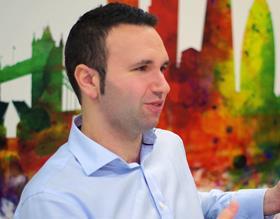Many professionals in our male-dominated industry say they want to spend more time with their children. So why aren’t new dads taking up their recent right to shared parental leave? We talk to two fathers who took time out of the workplace

You may remember the outraged headlines a couple of months ago: only 1% of fathers take up their right to shared parental leave. The media ran this story in April, one year after new rules came into force giving fathers rights to share leave with their partner during their baby’s first year.
Shared parental leave gives couples a total of 52 weeks, 39 of which receive some pay. Mothers have to take the first two weeks after the birth but can then transfer the rest to the father. Except it seems that this is not happening. Research by My Family Care and the Women’s Business Council, who contacted 200 employers, was reported to show that only 1% of fathers had opted to take their new entitlements.
However, this picture may be a little more complicated than the research first appeared to suggest. The BBC’s statistics programme on Radio 4, More or Less, found that the survey was put to all men, whether or not they had had a child. The misleading reporting is unfortunate because the 1% statistic can give the perception that if a male employee asks for shared leave they will be the odd one out.
Low take-up
While reporting on this issue may be alarmist, it’s hard to find evidence of widespread take-up of the recent entitlement. The government’s own estimates show that 285,000 working fathers are eligible for shared parental leave but it is reported to expect no more than 8% will take advantage of it. This compares with other countries such as Sweden where close to 90% of fathers take parental leave. The problem may be a financial one: statutory pay for shared parental leave in the UK is a maximum of £139.58 a week, or 90% of earnings, whichever is lower. Many parenting experts also think that the fault lies in the way shared leave is structured. The rules mean that when a father takes a certain amount of leave the mother loses that time from her leave. Other international models give both parents their own individual allocation of leave, paid at a rate that is in line with their earnings. The government is reportedly due to evaluate its policy by 2018.
While we don’t have the numbers, it seems likely that fathers taking parental leave in the construction sector are in a minority. However, anecdotally many do want to take time off work to spend time at home with their family. And savvy employers in this male-dominated industry that are keen to promote a good work/life balance and equality in the workplace are encouraging them to do so. Here, we talk to three fathers in construction, two in the UK and one in Sweden, about their reasons for taking time out of the office and their experiences of being at home after the birth of their child.
‘Equality at home’

Finn Williams, regeneration area manager at the Greater London Authority (and co-curator of the British Pavilion at the Venice Architecture Biennale 2016), age 34
Q. Why did you opt to take shared parental leave?
A. Two reasons: personally, because I wanted the opportunity to spend as much time with my son as my partner. And I suppose politically, because I think we’re not going to get equality in the workplace until we have equality at home. My partner’s Swedish, so I’d seen how well it works over there when parents share childcare evenly.
Q. How many weeks additional leave did you take?
A. We split the parental leave 50:50. My partner took the first six months, I took the second six months.
Q. How have others reacted to your decision to take time out of the workplace to look after your family?
A. My employers and everyone I work with have been completely supportive. People’s initial reaction has sometimes been a surprise. But then there’s a recognition that if it’s ok for mothers to take maternity leave, it shouldn’t be any different for fathers. And it’s encouraged at least six dads I know to take more than the statutory two weeks.
Q. Some media reports suggest there is a low take-up of shared parental leave by fathers, what do you think is holding them back?
A. It’s partly about people knowing the opportunity exists. It’s partly because not all mothers want to go back to work sooner than 12 months. But mainly, I think it’s because of cultural and social preconceptions that are built into the way we think about work, and the family, that we’re often not even aware of. That kind of structural gender inequality will probably take generations to overturn. In Sweden, there are incentives like “use it or lose it” quotas to encourage more take-up of paternity leave.
Q. What’s top of your list of fun things to do while on paternity leave?
A. I started off my six months with the aim of going to a new exhibition every day. I kept it up for about a week. But I did still go to museums and galleries fairly often to meet up with people who I might otherwise have been too busy to see. I doubt much of the culture rubbed off on me (or my son), but the conversations were valuable - both for company then, and for ideas that are still feeding into my work.
‘Wonderful nine months’

Martin Johnson, architect, White Arkitekter, Stockholm, Sweden, age 33
Q. Why did you opt to take paternity leave?
A. In 2014 my daughter was born and as all parents I want to build a great life for her and take equal responsibility. The best way to do this is surely not by only earning money and seeing her very little. Taking parental leave has enabled us to share the parenting responsibility. It has been good for my wife and I. We can both go to work to do what we love, but don’t have to do it with all our time and exhaust our passions, while the other is solely looking after our child. I don’t want my daughter to grow up and earn less money because of her gender and to be excluded from possibilities because she may choose to have a child of her own. This has been an opportunity for me to contribute to how I want the world to be.
Q. How many weeks paternity/shared parental leave are fathers in Sweden entitled to take?
A. Parents have a shared 480 days of which 90 days are reserved for each parent to take. The rest of the days can be shared as wished and up until the child is seven.
Q. How many weeks did you take? Is your experience typical in Sweden?
A. I took two weeks off when my daughter was born and then a further nine months paternity leave from when she was nine months old. I believe that is fairly typical within the sector of Swedish society that I am a part of but it isn’t the case across the whole nation and socioeconomic groups. Sweden as a whole still has a long way to go.
Q. Has the experience of caring for your child at home matched your expectations?
A. Yes, I had a wonderful nine months and had a great opportunity to build a solid relationship with my daughter. It has given me a different understanding and experience of the world, which I know will also help me in the workplace.
Q. What could the UK learn from the system in Sweden?
A. It is not only down to the system but also the culture of the workplace. When I told my boss at work he said that I now live in Sweden and need to take parental leave. I think the main systematic change that the UK could do is to implement a number of days that only the father can take off and cannot be traded between parents.
Q. What’s top of your list of fun things to do while on paternity leave?
A. The seasons are very different here in Sweden and over nine months I experienced most times of year. In the winter my favourite activity was sledging with Mabel and in the summer it was to explore the city trying to find ducks, buses, swings and other kids to interact with. It was a great time for getting to know Stockholm and especially seeing it through her wonderment.
‘A very rewarding experience’

Richard Powell, associate at Alinea Consulting, age 30
Q. Why did you opt to take additional paternity leave?
A. I took two weeks paternity leave in total, a week of which was fully paid, given as part of our enhanced benefits package at Alinea. This helped out significantly in light of all of the new outgoings that you have. I decided to take my two weeks off in a total block, in order to enjoy it more and be around more initially to help out. I have had friends who decided to take some time off and then break up their second week into ad hoc days.
Q. How many weeks additional leave did you take?
A. I took two weeks in total so no additional weeks above the statutory allowance, but I chose to take as a combined allowance, as mentioned above.
Q. Has the experience of caring for your child at home matched your expectations?
A. Yes - my expectations were that it would be a very rewarding experience. I had an idea of what to expect through attending NCT classes and speaking with friends and colleagues who had recently had children, in that your support at home is a must when there is so much to do and your partner and you are running on little sleep. Our little girl arrived over three weeks early which was even more of a surprise as we had only finished decorating the upstairs the night beforehand, so my support at home was required even more so. My colleagues and the partners at Alinea were extremely supportive of my early departure, given I had only just started the handover process at work.
Q. How have others reacted to your decision to take time out of the workplace to look after your family?
A. Colleagues were very supportive of me taking a two week block of time at short notice to be around at home and offer support. Many could completely relate to it as they’d had similar experiences.
Q. Some media reports suggest there is a low take up of shared parental leave by fathers. What do you think is holding them back? What would persuade more dads to spend more time at home?
A. Interesting question. I think a key driver for the low take up is career focused fathers. They are likely to find it difficult to take longer time off work / spend more time at home, given their level of ambition / commitment at work. Perhaps there may be a route through for a midway working from home arrangement (depending on their employment position) but this is only viable to some extent, what with meeting commitments and communicating with colleagues face to face.
Q. What’s top of your list of fun things to do while on paternity leave?
A. Seeing friends and family, without a doubt. We had people over every day and it made me feel really proud introducing them to our daughter and us all spending really memorable time together.
Shared Parental Leave facts:
- To qualify for SPL you must have 26 weeks’ continuous employment
- SPL also applies for adopters and surrogate parents
- SPL taken by one partner will reduce the amount available for the other
- You can book up to three separate blocks of SPL instead of taking it in one go
- You must give your employer at least eight weeks’ notice before you begin a block of leave.

Are you an excellent equal opportunities employer? To enquire about entering for the Good Employer Guide,
click here




























No comments yet